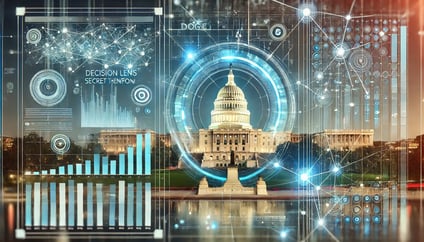In this article
We are often asked if or how Decision Lens leverages Artificial Intelligence (AI). The short answer is, yes – and we’ve been doing it for a long time! But before we delve into how our software uses artificial intelligence to modernize how the government prioritizes, plans, and funds, it is important to categorize the different flavors of AI – which we define as intelligence demonstrated by machines.
- Generative AI (GAI) is a type of artificial intelligence that can create original content, such as text, images, or videos, in response to user prompts by learning from existing data patterns.
- Large Language Models (LLM) are a type of artificial intelligence that uses deep learning techniques to understand and generate human language. LLMs are trained on vast datasets, allowing them to perform various natural language processing tasks, such as text generation and translation.
- Machine Learning (ML) is a field within AI that uses and develops statistical algorithms that can learn from and make predictions without specific programming.
- Genetic Algorithm is one that mimics life evolving, where better solutions are found by merging good parts of other solutions and letting the best fight it out. Genetic algorithms, or GAs, are artificial intelligence because the solutions they arrive at are intelligent solutions to our given planning problem, generated by computers without need of human directly guiding each step of the process.
Today, AI has become synonymous with LLMs but as highlighted above, but as outlined above, LLMs are just one type of artificial intelligence. We’ve learned that each type has its strengths and weakness, places where they work well and places they struggle depending on the problem you are trying to solve. LLMs are great for some problems while others might require deep networks, clustering algorithms, k Nearest Neighbor (kNN), genetic and evolutionary algorithms, or something else entirely.
At Decision Lens, we’ve incorporated genetic algorithms to solve various planning problems. This approach allows users to set the parameters of the optimization while the GA effectively searches that space and discovers novel and intelligent solutions that would not be discoverable otherwise. Genetic algorithms can be designed to be as precise and reliable as any standard optimization algorithm, while still proceeding along an intelligent pathway to get there. Genetic algorithms can even describe naturally how that solution evolved and how it got better over that process.
In each case, Decision Lens begins the evolutionary process by finding intelligent initial solutions as well as providing a plethora of other solutions to allow for genetic diversity in the outcomes. As the solutions evolve, they find better and better answers that would be impossible to find via brute force or other standard approaches.
Some examples of where you’ll find Genetic Algorithms in our application include:
- Scenario Planning - for instance finding the least destructive way to cut 5% of the budget.
- Debottlenecker - better layout schedules against resourcing constraints.
While GAs play a critical role in our software, the emergence of LLMs present new opportunities to further evolve our offerings. LLMs are brilliant at synopsizing text and this opens up new input and output capabilities. We are currently working on LLM generated overviews of comments, projects and planning options. Additionally, we are researching LLMs and other AI techniques that can assist throughout the decision-making process.
Decision Lens has long made use of machine learning in our products and will continue to integrate advanced capabilities to deliver cutting edge software which allows for better understanding the choices planners have as well as their consequences.




